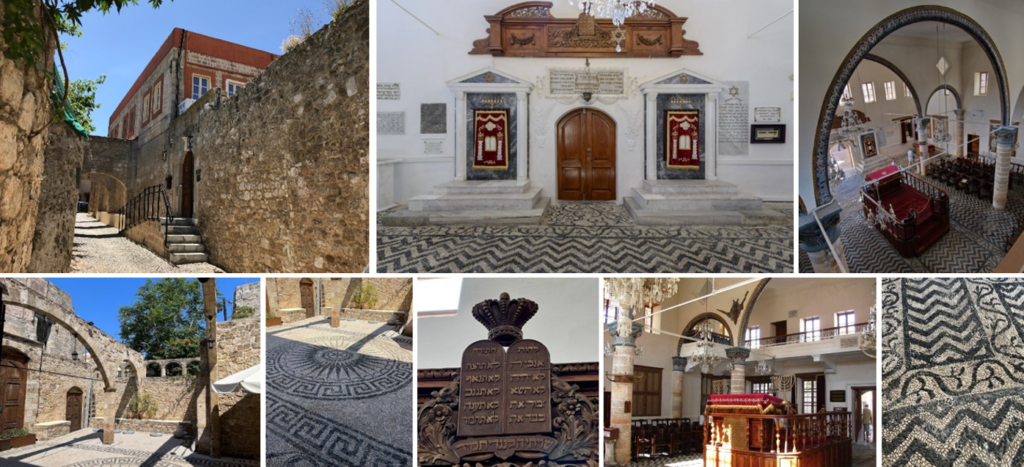
Tu Be-Av (ט”ו באב)
The Talmud in the treatise Ta’anit (26b), reports that Av 15 is one of the happiest days of the year. That day meetings for marriage were organized.
Va’et’hanan (ואתחנן – and I pleaded) Deuteronomy 3: 23-7:11
Moshe exhorts the children of Israel to remain faithful to the covenant contracted at Sinai, insists on the uniqueness of the Torah, reiterates the Ten Words and proclaims the Shema; שְׁמַע, יִשְׂרָאֵל: יי אֱלֹכֵינוּ, יי אֶחָד. The two large letters (in red) of the verse form the word עד (Ed – witness).
Israel a consecrated people, a people apart.
Deuteronomy Chapter 7 – ז’ דְּבָרִים
ו כי עם קדוש אתה, לַיי אלכיך: בך י יי אלכיך, להיות לו סגלה, מכֹל העמים, אשר על-פּני האדמה.
Since antiquity the Jewish presence in Rhodes is attested2. In the 12th century, Benjamin of Tudela3 attests to the presence of 400 Jews in the city. At the beginning of the 14th century the Hospitallers4 conquered Rhodes. Gradually the community diminished (earthquake, plague) and at the end of the 15th century, the Hospitallers expelled the twenty Jews still present in Rhodes. At the beginning of the 16th century, they brought more than 2,000 Sephardic Jews there, exploited as slaves. In 1522, the island was conquered by the Ottomans. Under their rule, the community thrives. At the beginning of the 20th century, the island was occupied by the Italian fascists and most of the Jewish5 community of Rhodes, feeling threatened, emigrated to the Belgian Congo6. In September 1943, the Italians having signed the armistice7, Rhodes was occupied by the Nazis. On July 23, 1944, 1,673 Jews from Rhodes were deported to Auschwitz. A commemorative plaque, in French, is dedicated to members of the community who died during the Holocaust, but most of the plaques that adorn the synagogue are in Ladino7.
The Kal Kadosh Shalom8 Synagogue is the only one of the four synagogues in the Juderia9 not to have been destroyed by bombardment. It was built in Kislev 5338 (Nov./Dec. 1577), the date inscribed on the fountain located in the entrance courtyard. It is the oldest synagogue in Greece. Two holy arches, as if symbolizing the two tables of stone on which the Ten Words are engraved, frame a door leading to a courtyard. From this courtyard one once accessed the yeshiva10. On the ground, a mosaic of black and white pebbles.
1 Roman decree, dated 142 AEC and reported in Book I of Maccabees.
2 Rabbi, born in Tudela (circa 1130-1173), author of the Sefer massa’ot. He is a major figure in medieval Jewish geography and history.
3 Also called the Order of St. John of Jerusalem, is a hospitable and military Catholic religious order which existed from the time of the Crusades until the beginning of the 19thth century.
4 During the census carried out in 1931, the Italians counted 4,372 Jews.
5 At the independence of the Belgian Congo, the Jews joined Belgium.
6 The armistice signed secretly on September 3, 1943 in Cassibile, by which the Kingdom of Italy ceased hostilities against the Allied forces.
7 Judeo-Romance language derived from 15th century Old Castilian and Hebrew. Ladino is also called Judeo-Spanish, judesmo, spanyolit, djudyo, tetuani, haketiya, spanyol depending on the place.
8 בית הכנסת קהל קדוש שלום – synagogue of the holy congregation of peace.
9 ‘לה ג’ודיריה’ – Jewish quarter in the city of Rhodes, on the Greek island of Rhodes.
10 Destroyed during the war.
